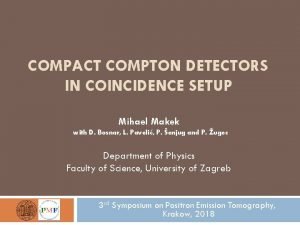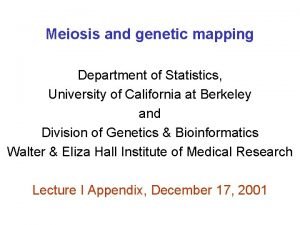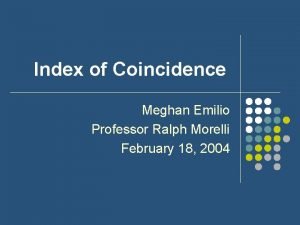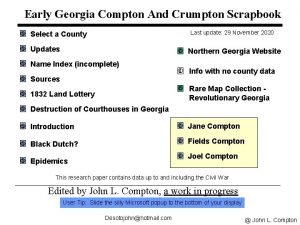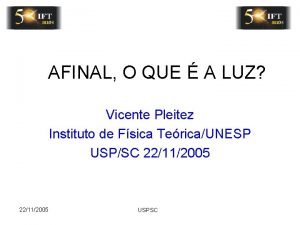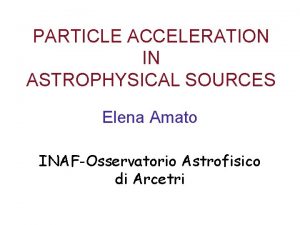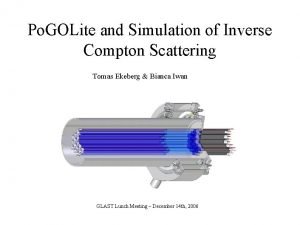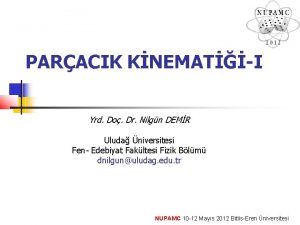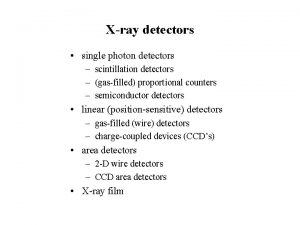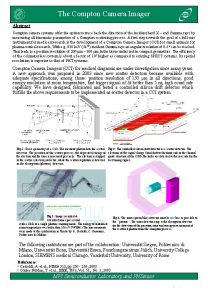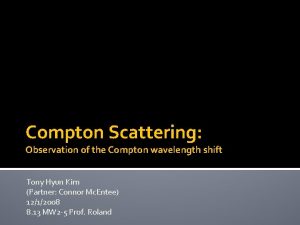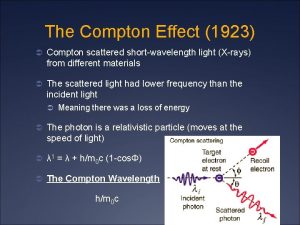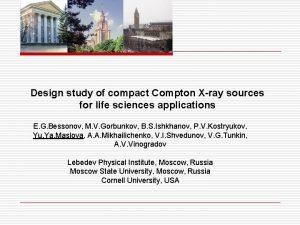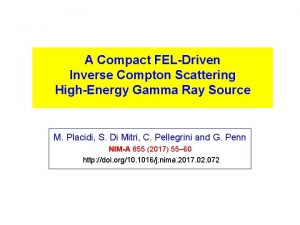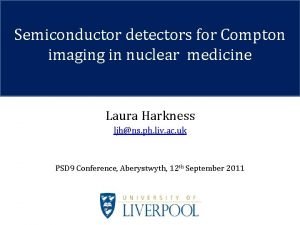COMPACT COMPTON DETECTORS IN COINCIDENCE SETUP Mihael Makek




































- Slides: 36

COMPACT COMPTON DETECTORS IN COINCIDENCE SETUP Mihael Makek with D. Bosnar, L. Pavelić, P. Šenjug and P. Žugec Department of Physics Faculty of Science, University of Zagreb 3 rd Symposium on Positron Emission Tomography, Krakow, 2018

Outline Motivation LFS scintillator pixel arrays Detector performance Compton measurements using LFS scintillator pixel array Evidence of polarization correlations of gamma rays from positron annihilation Krakow, 2018 Mihael Makek 2

Motivation Gamma quanta from positron annihilation are polarized in orthogonal directions owing to conservation of quantum numbers [P. Dirac, Proc. Camb. Philos. Soc. 26(1930)361; R. Hanna, Nature 162(1948)332] Image from: Mc. Namara et al. , Phys. Med. Biol 59 (2014) Can the polarization correlation be utilized as an additional handle in PET and/or fundamental measurements? How to (efficiently) measure gamma polarization? Krakow, 2018 Mihael Makek 3

How to measure the polarization correlations of gamma quanta? Gamma is most likely to be Compton scattered at azimuthal angle f perpendicular to the polarization vector (Klein-Nishina relation): Polarization can be correlated to the azimuthal scattering angle f For 2 g scattering, the azimuthal assymetry r 1 defined as the ratio of the cross section for both gama scattering at Df =90° thus preserving the correlation, to the cross section for scattering at Df =0° thus loosing the correlation is: where [Snyder, Pasternak, Hornbostel, Phys. Rev. 73 (1948) 440 -8] r 1 is sensitive to polar angle q with maximum at q ~ 90° (for both gammas) Krakow, 2018 Mihael Makek 4

Utilization of polarization correlations in PET? Simulation studies using idealized detectors show potential of polarization correlations for implemenation in PET, e. g. : Kuncic et al. , NIM A 648(2011) Mc. Namara et al. , Phys. Med. Biol 59 (2014) M. Toghyani et al. , Phys. Med. Biol 61 5803 -5817(2016) Usual setups for polarization measurement: detectors with 2 layers – 1 st for measuring the scattered electron, 2 nd for the scattered gamma complex and more expensive than current PET detectors (generally 2 x number of electronic channels) Investigate the feasibility of the measurement of polarization correlations usingle-layer detectors Krakow, 2018 Mihael Makek 5

Scintillation pixel setup for Compton measurements 2 modules – 16 channels each: 3 mm x 20 mm LFS pixels in 4 x 4 matrix 4 x 4 MPPC array (S 13361‐ 3050 AE Hamamatsu) Passive base amplifier (Ai. T instruments) Digitizer up to 3. 2 GS/s (CAEN V 1743) [M. Makek, D. Bosnar, V. Gačić, L. Pavelić, P. Šenjug, P. Žugec, Acta Physica Polonica B, vol. 48 (2017)] Krakow, 2018 Mihael Makek 6

LFS scintillator Lutetium Fine Silicate (Zecotec patent) Crystal/Property 4 x 4 array LFS LYSO 7. 35 7. 1 64 66 Atten. Length [cm] 1. 15 1. 12 Decay constant [ns] <33 41 Max. emission [nm] 425 Light yield [% Na. I] 80 -85 70 -80 1. 81 Hygroscopic No No Active Yes x -33. 14 Density 3. 14 [gcm ] x 20 3 Zeff mm Refractive index Krakow, 2018 1 layer~0. 06 mm Mihael Makek 420 7

MPPC arrays 4 x 4 MPPC array (S 13361‐ 3050 AE Hamamatsu) Main features: Number of micro-cells 3584/pixel Micro-cell pitch = 50 mm Fill factor 74% Epoxy window, n=1. 55 Vbr ~ 53 V 1 p. e. PDE (typical) ~ 40% 2 p. e. Spectral range 320 -900 nm 3 p. e. (max at 450 nm) Krakow, 2018 Mihael Makek 8

Amplifiers 16 -channel Passive base: selectable cable length Matching base depending on the Si. PM model and manufacturer Sum output with selectable gain and offset Output signals: 50 Ohm maximum -2 V Rise-time ~ 10 -15 ns (depending on cable length) Krakow, 2018 Mihael Makek 9

Digitizers CAEN model V 1743 16 channel, switched capacitor (based on SAMLONG chip) 1024 samples/channel 7 events/channel buffer Up to 3. 2 GHz sampling rate Selectable trigger logic Multi-board synchronization enabled Individual readout for all crystal channles Krakow, 2018 Mihael Makek 10

Setup and trigger 16 ch. Amp. 16 ch. digitizer 16 ch. Amp. 22 Na OR TRG IN Krakow, 2018 OR AND Mihael Makek 16 ch. digitizer TRG IN 11

Acquired signals Sampled at 1. 6 GHz Vop = Vbr+1. 5 V Rise-time ~ 15 ns Time reconstructed when crossing threshold on the leading edge Energy reconstructed by signal integration Krakow, 2018 Mihael Makek 12

Reconstructed energy spectrum Bias voltage = Vbr + 1. 6 V Energy reconstruction: (i) integrate signal, (ii) subtract base line, (iii) correct for nonlinearity DE/E @ 511 ke. V= 13, 2% Krakow, 2017 Mihael Makek 13

Use of optical coupling (new: August 2018) Bias voltage = Vbr + 1. 6 V Without optical grease With Si optical grease DE/E @ 511 ke. V= 13, 2% DE/E @ 511 ke. V= 11, 6% Amplitude i. e. No. of fired cells increase by ~ 40 % Corresponding to energy resolution improvement by ~ 1/√ 1. 4 *The following results are from measurements conducted in 2017/2018, without optical coupling Krakow, 2017 Mihael Makek 14

Time reconstruction Extract the time at a threshold at the leading edge: Set the threshold just above the noise level Determine the sample S above threshold Time determined from linear interpolation between (S-1, S) In this example signals sampled at 1. 6 GS/s Krakow, 2018 Mihael Makek 15

Coincidence time spectrum Select one pixel in each module Select events by ± 2 s cut on photo peak in each pixel Reconstruct time from the leading edge of the signal Correct for walk from t 1 -t 2 vs. E 1 -E 2 plot Plot corrected time spectrum: Dtcorr = t 1 -t 2 - a x (E 1 -E 2) Obtained Coincidence time resolution (FWHM): Dt = a (E 1 -E 2) + b Vbias=Vbr+1. 6 CTR = 600 ps Vbias=Vbr+3. 1 CTR = 440 ps Krakow, 2018 Mihael Makek 16

Compton scattering measurement Krakow, 2018 Mihael Makek 17

Compton event reconstruction Energy spectra of single pixels Energy sum of 2 neighbor pixels 5 6 Selected events Krakow, 2018 üSum shifted by ~ 35 ke. V due to 2 x noise and light sharing between the pixels üEnergy resolution ~ 11. 3 % consistent with E. res. of the photo peak 2 x dark noise compensated by extra light from light sharing Mihael Makek 18

Compton event reconstruction Energy spectra of single pixels Energy sum of 2 non-neighbor pixels 4 5 6 Selected events Krakow, 2018 üSum shifted by ~ 10 ke. V due to dark noise from both pixels üEnergy resolution ~ 12. 3 % slightly degraded compared to photo peak due to dark noise from both pixels Mihael Makek 19

Coincidence time spectrum (Compton events) Select Compoton energy range in two pixels: 150 – 400 ke. V Reconstruct time from LE and plot Dt Correct for walk from DE vs. Dt plot Plot corrected time spectrum: Dtcorr = Dt - a DE Dt ==a 900 DE + CTR psb Obtained Coincidence time resolution (FWHM): Vbias=Vbr+1. 6 CTR = 900 ps Krakow, 2018 Mihael Makek 20

Evidence of polarization correlations of gamma rays from positron annihilation Krakow, 2018 Mihael Makek 21

Compact Compton Coincidence System Single layer Compton detectors Pixel array with single side readout – price advantage q reconstruction by energy, f by geometry of fired pixels g g e +e - Possible coinstraints: Energy resolution determines q precision Segmentation and material determine f resolution Ambiguity in identification of 1 st and 2 nd pixel – impact on LOR reconstrucion in PET Krakow, 2018 Mihael Makek 22

Proof of Concept Simplified measurement using only one central pixel and four adjacent pixels in each module 22 Na source positioned on line connecting the central pixels of modules 5 cm from each module 60 k coincidence events recorded with both central pixels fired, of which: 10 k events with full energy deposition in both central pixels 20 k events with both central pixels in Compton range 2. 5 k events with both central pixels in Compton range AND g energy fully deposited in the modules 2. 3 k events with both central pixels in Compton range AND g energy fully deposited in exactly TWO pixels Use to reconstruct polarization correlations 23

Analysis Cuts to select 2 -pixel Compton events in each module: Select energy range 120 – 420 ke. V in the central pixel Require that Ecentral + Eadj = 511 ke. V ± 3 s Additionally select q of each gamma by energy cuts: q [min – max] Elow [ke. V] Ehigh [ke. V] 70°-120° >200 260 – 350 75°-110° >215 260 – 335 80°-102° >230 260 – 325 Where Elow (Ehigh) is the energy of the pixel with lower (higher) energy in the pair Count the events with perpendicular Df=“ 90°” pixel pairs and paralel pixel pairs Df=“ 0°” Krakow, 2018 Mihael Makek 24

Evidence of polarization correlations Df = “ 0°” Df = “ 90°” Observe more events with Df = “ 90°” than Df = “ 0°” Prelim inary, not ef fi ciency correc ted! q = 80° - 102° PRE LIMI NA RY q [min – max] Elow [ke. V] Ehigh [ke. V] N 90° / N 0° 70°-120° >200 260 – 350 1. 4 ± 0. 1 75°-110° >215 260 – 335 1. 5 ± 0. 2 80°-102° >230 260 – 325 2. 0 ± 0. 3 Polarization measurement sensitivity increases for q ~ 90° evidence for polarization correlations Krakow, 2018 Mihael Makek 25

Summary LFS pixel arrays demonstrate solid energy and time performance: DE/E (@ 511 ke. V) up to 11% achieved CTR (@ 511 ke. V) ~ 440 ps potential for improvement at higher overvoltages Coincidence Compton events measured in the compact 2 -module setup Evidence of polarization correlations of annihilation quanta observed Krakow, 2018 Mihael Makek 26

ACKNOWLEDGEMENTS Work supported by: Croatian Agency for Small and Medium Enterprises, Innovations and Investments (HAMAG-BICRO), Proof-of-Concept Programme, Project Po. C 6_1_ 211 European Cooperation for Science and Technology Action TD 1401: Fast Advanced Scintillation Timing (http: //cern. ch/fast-cost) Krakow, 2018 Mihael Makek 27

BACKUP SLIDES Krakow, 2018 Mihael Makek 28

Single pixel full spectrum Krakow, 2018 Mihael Makek 29

Non-linearity correction Limited number of micro-cells causes saturation of large signals The relation between incident photons (Nph)and fired cells (Nfired): M is the total number of micro-cells, PDE is photon detection efficiency calculated as product of QE(l), Pav (V, T) and fill factor Apply correction: Original Corrected where Nfired is obtained empirically: Krakow, 2018 201 ke. V from 176 Lu 306 ke. V from 176 Lu Mihael Makek 511 ke. V from 22 Na 30

Light sharing Calibration: sum of all fired channels = 511 ke. V Light sharing significant bewteen adjacent pixels. 0, 06 mm teflon too thin! Single pixel energy resolution degradation @511 ke. V: 11% 13% Energy deposition: Leading/total ~ 80% S 1 st neighbors/total ~ 20% 2 nd neighors/total ~ negligible Krakow, 2018 Mihael Makek 31

One photo-electon amplitude Measured on oscilloscope Map temperature and voltage dependence for both detectors Vbr(1) = 52. 1 V Vbr(2) = 52. 2 V Krakow, 2018 Mihael Makek 32

Number of fired micro-cells @511 ke. V Mean number of fired cells at 511 ke. V vs: Voltage Temperature Reflects how PDE changes with temperature and voltage Impact on energy resolution Krakow, 2018 Mihael Makek 33

511 ke. V photo-peak amplitude Mean signal amplitude at 511 ke. V vs. Voltage and Temperature (Range limited by amplifier gain) üChange of amplitude with V ~equally driven by the number of fired cells and 1 p. e. amplitude üChange of amplitude with temp. dominantly driven by 1 p. e. amplitude Krakow, 2018 Mihael Makek 34

Energy calibration procedure 1) 2) 3) Correct each channel for non-linearity (event-by-event) Calibrate the photo peak in each channel to 511 ke. V Repeat procedure for each run (approx 1 h of data taking) The self-calibration on coincidence data is stable wrt to temperature and voltage change no need to pre-calibrate the setup Krakow, 2018 Mihael Makek 35

Energy resolution (511 ke. V gamma) Energy resolution improves with Vbias in the measured range Negligible dependence on temperature in the measured range Usable operating range: Vbr + 2 V Limited by amplifier gain which causes saturation for signals > 2 V Krakow, 2017 Mihael Makek 36
 Mihael makek
Mihael makek Plastic compact semi compact slender
Plastic compact semi compact slender Mihael gabrijel rafael
Mihael gabrijel rafael Transverzalne vještine
Transverzalne vještine Coefficient of coincidence
Coefficient of coincidence A double coincidence of wants
A double coincidence of wants Interesting sentence structures
Interesting sentence structures Coincidence vs irony
Coincidence vs irony The double coincidence of wants
The double coincidence of wants Esther
Esther Ralph morelli
Ralph morelli Vhv voltage detectors
Vhv voltage detectors Giant wave detectors murmurs universe
Giant wave detectors murmurs universe Feature vectors
Feature vectors Yodsawalai chodpathumwan
Yodsawalai chodpathumwan Photo detectors
Photo detectors Giant gravitational detectors hear murmurs across
Giant gravitational detectors hear murmurs across Feature detectors
Feature detectors What is thermal detector
What is thermal detector Nuclear detectors
Nuclear detectors Where are feature detectors located
Where are feature detectors located Streaming current
Streaming current Detectors used in hplc
Detectors used in hplc Kinesthesis and vestibular sense
Kinesthesis and vestibular sense Frontier detectors for frontier physics
Frontier detectors for frontier physics Victorian curriculum economics and business
Victorian curriculum economics and business Keisoni
Keisoni Fóton
Fóton Watson health francisco 1b
Watson health francisco 1b Inverse compton
Inverse compton Crisi della fisica classica
Crisi della fisica classica Golite trig 2
Golite trig 2 Efecto compton
Efecto compton Youth wildcat offense
Youth wildcat offense Compton saçılması
Compton saçılması Compton olayi
Compton olayi Kesme gerilimi fotoelektrik
Kesme gerilimi fotoelektrik
